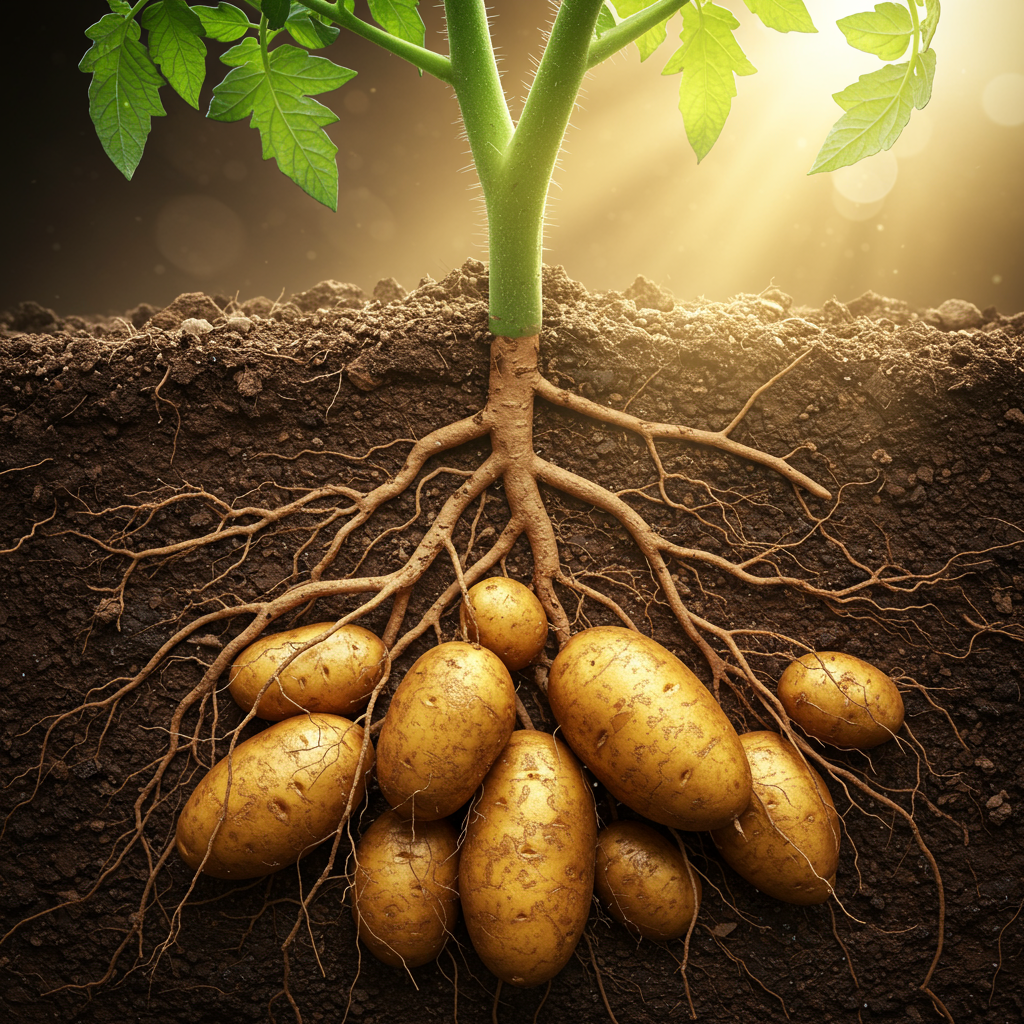For decades, the humble potato’s lineage remained a baffling mystery to scientists. How did this global staple, so distinct in its underground tubers, truly emerge? Breakthrough research has finally unveiled a remarkable truth: your crispy fries and creamy mashed potatoes owe their existence to an ancient, unexpected union. Millions of years ago, the very first potato lineage sprang from a rare, yet highly successful, crossbreeding event between an ancient tomato and a related wild plant from the Etuberosum group. This discovery reshapes our understanding of evolution and promises new avenues for sustainable agriculture.
The Unlikely Evolutionary Marriage
Evolutionary history often highlights the challenges of interspecies breeding. Hybrids, like mules, are typically sterile or face severe health issues. For many years, scientists, including plant taxonomist Sandra Knapp, viewed such hybridization as a “hapless” force, rarely leading to successful new species. Yet, a groundbreaking study, co-authored by Knapp and her colleagues, challenges this long-held “dour view.” It reveals that with the right genetic combination, hybrids can not only be fertile but also acquire extraordinary new abilities, enabling them to thrive in ways their parents never could.
This new research pinpoints such a pivotal event around 9 million years ago. In the rugged foothills of the ancient Andes, a flowering plant from the Etuberosum group encountered an ancient tomato plant. While both belonged to the nightshade family – a diverse group that also includes eggplants and peppers – they were distinct species. Their fortuitous pairing laid the genetic foundation for Solanum tuberosum, the ancestor of our modern potato. This incredible genetic fusion became a testament to evolution’s surprising capacity for innovation.
Solving the Potato Paradox: Genomic Clues Emerge
Scientists had long grappled with the potato’s origins due to its complex and “messy” genetics. Plant geneticist Ek Han Tan noted the difficulty in mapping relationships among the 100-plus wild potato species. Conflicting clues added to the enigma. On one hand, large sections of the potato genome closely resembled that of tomatoes, even allowing them to be grafted together. On the other, parts of the potato genome mirrored Etuberosum, which, despite lacking tubers, possessed more potato-like underground stems and flowers. As biologist Zhiyang Zhang, a lead author of the new study, explained, this “contradiction” remained unresolved for a considerable time.
To unravel this “potato paradox,” Zhang and his team, including lead author Yiyuan Ding, embarked on an extensive genomic investigation. They amassed and meticulously analyzed over 120 genomes from dozens of species spanning the potato, tomato, and Etuberosum groups. Their key finding was a consistent genetic signature across all sequenced potato genomes: an identical split of genetic material derived equally from both tomato and Etuberosum. This pattern conclusively pointed to a single, ancient origin for the entire potato lineage, stemming directly from a stable fusion of these two ancestral plants, rather than a gradual divergence and later crossbreeding. Helen Tai, a plant geneticist, remarked that this possibility had not been previously considered by potato researchers.
The Birth of Tubers: A Revolutionary Adaptation
The most astonishing evolutionary leap from this improbable union was the development of tubers – the edible underground nutrient-storage organs that define potatoes. Neither the ancient tomato nor the Etuberosum parent possessed the ability to form these vital structures. Each lacked crucial genetic components necessary for tuber growth. However, the proto-potato hybrid hit the genetic jackpot. It acquired the perfect combination: the structural scaffold of underground stems from Etuberosum and a “genomic switch,” specifically the SP6A gene, from the tomato lineage that instructed these stems to swell and store nutrients. Another vital gene, IT1, from Etuberosum, helped regulate stem growth into tubers. Without either gene, edible potato tubers would not form.
This newfound ability to tuberize was a game-changer for the proto-potato. As C. Robin Buell, a plant-genomics expert, highlighted, tubers enabled the plant to survive and flourish in harsh, stressful environments where its parents could not. Coinciding with the rapid uplift of the Andes mountains, which created new, colder, higher, and drier habitats, tubers offered a secure underground food and water reserve. This allowed the proto-potato to spread rapidly, colonizing regions as far north as Arizona and west to the coasts of Argentina, Uruguay, and Brazil.
Hybridization: An Underestimated Force
While hybridization often results in evolutionary dead ends, the potato’s story serves as a powerful reminder that it can also be a driving force for incredible innovation. As evolutionary biologist Robin Hopkins noted, occasionally, the “risky gamble of interspecies pairings” pays off spectacularly. We see other examples in nature: East African cichlids gained diverse eyesight genes through hybridization, helping them navigate varied waters. Certain frogs deliberately seek mates outside their species to boost offspring survival during droughts. Even our own ancestors intermingled with Denisovans and Neanderthals, acquiring adaptive traits.
Farmers have long leveraged this power, frequently breeding different crop species to enhance yield or boost resilience against extreme weather and disease. Yet, the potato’s evolutionary path remains exceptional. Rather than merely combining its parents’ existing traits, this ancient hybrid embarked on an entirely new evolutionary trajectory, developing a novel organ that reshaped its survival strategy. The initial hybrid also leveraged asexual reproduction (propagating via its tubers) to stabilize its beneficial gene combinations, allowing it to establish itself before eventually regaining the capacity for sexual reproduction. This combination led to the rapid diversification into the 100-plus potato species we see today.
Future Implications: Cultivating Sustainable Spuds
Understanding the potato’s evolutionary origins holds profound implications for modern agriculture. Today’s cultivated potatoes are prone to diseases and challenging to breed. Their complex tetraploid genomes, with four copies of each chromosome, make genetic manipulation a painstaking process that can take decades. Researchers are exploring solutions like developing two-copy-genome potatoes to simplify breeding.
However, as biologist Yiyuan Ding suggests, this new historical insight offers a fresh avenue toward sustainable spud production. With genetic assistance from Etuberosum, scientists might one day “coax” tomato plants into producing edible underground tubers. Imagine a future where a single plant could yield both tomatoes above ground and potatoes below – a true “TomTato” plant born from understanding its ancient ancestry. This discovery could pave the way for more resilient, disease-resistant crops, crucial for global food security, especially in the face of rapid climate change. The potato, one of humanity’s most remarkable food staples, continues to inspire innovation.
Frequently Asked Questions
How did potatoes get their unique underground tubers?
Potatoes developed their distinctive tubers from a precise genetic fusion during an ancient hybridization event. Approximately 9 million years ago, an ancient tomato plant contributed the crucial SP6A gene, acting as a “switch” to initiate tuber growth. Simultaneously, an Etuberosum plant provided the IT1 gene, which guided the development of underground stems into the structures needed for tubers. Neither parent alone could form tubers, but their combined genetic material in the hybrid created this revolutionary adaptation, allowing the plant to store nutrients and water efficiently underground.
Why was solving the potato’s evolutionary origin so challenging?
The potato’s origin remained a mystery for decades due to its complex and “messy” genetics. Researchers struggled with conflicting genomic clues; parts of the potato genome resembled tomatoes, while others were more akin to Etuberosum plants. Furthermore, cultivated potatoes are tetraploid, meaning they have four copies of their genome, which complicates genetic analysis and mapping relationships. It required extensive genomic sequencing of over 120 species and sophisticated analytical techniques to definitively piece together the ancient hybridization event that led to the potato lineage.
What does this discovery mean for future potato breeding and food security?
This groundbreaking discovery opens new doors for cultivating more resilient and sustainable potatoes. By understanding the precise genetic mechanisms behind tuber formation and the potato’s complex ancestry, scientists can explore innovative breeding strategies. For example, they might leverage the genetic insights to develop potatoes that are more disease-resistant or better adapted to harsh climates. The research even suggests the potential to genetically engineer tomato plants to produce underground tubers, creating novel food sources and addressing current challenges in potato cultivation, such as its complex breeding process and susceptibility to diseases.




